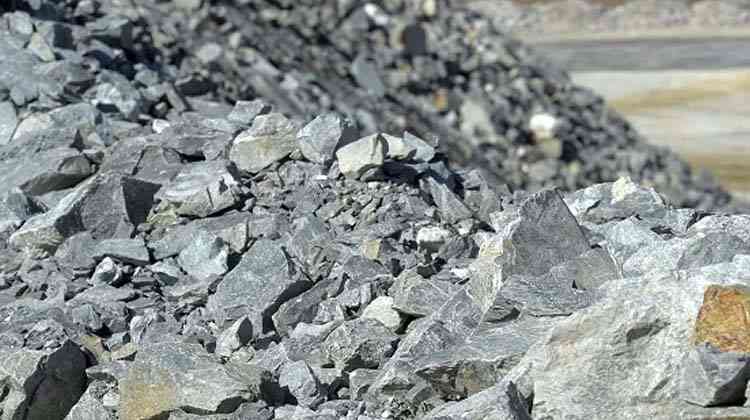
WITH the transition to green energy for the sake of managing climate change and dwindling oil resources, focus has now been increased on key minerals, which will play a vital role in the switch from fossil fuels.
These include lithium, cobalt, copper, uranium and others. Understanding such resources and their pertinence in the global economic environment, can go a long way to influence appropriate decisions relating to them, especially for policymakers.
As a central resource in the generation of clean energy, lithium is still shrouded in relative mystery, which will need to be unwrapped, for better comprehension of it.
From pricing, to manufacturing, global reserves, substitutes, and outlook, work needs to be done to arrive at a reliable evaluation of the commodity.
Having several applications, such as uses in the manufacturing of ceramic tiles, glass, nuclear weaponry, and so forth, the focus of this article, will be slanted towards the most widespread use of lithium, which is, in the manufacturing of lithium-ion batteries for electric vehicles (EVs).
Before setting off the more complex explanations, describing the production chain of lithium, from ore stage, to final battery-grade products, should be worth highlighting.
In this case, the example will illustrate using lithium ore, instead of brine and mud pools, as those sources are exotic to Zimbabwe.
On the market, lithium can be sold as ore, spodumene concentrate, lithium carbonate, or the final product, which is battery-grade lithium hydroxide.
- Zimbabwe deals help China tighten African lithium grip
- Zimbabwe deals help China tighten African lithium grip
- Zimbabwe’s huge say in US$60m lithium market
- Pioneering Zim lithium executive steps down
Keep Reading
The more that the commodity is processed, the higher its value. This implies that lithium ore is the cheapest to purchase. In spodumene concentrate, ore is treated in a plant to remove impurities, waste and non-lithium minerals.
Its current price range is around, a modest, US$5 000 per tonne. Lithium carbonate is recovered after further processing spodumene concentrate and adding complex chemicals in the production process.
Its average price on the Chinese spot market, in 2022, was US$37 000 for a tonne, with a peak of US$74 000.
Lithium hydroxide is the final product used in the manufacturing of EV batteries, alongside other components such as cobalt, etc.
As a final product in the extraction cycle, its price per tonne can be as much as 20% higher than lithium carbonate, according to Fast Markets, a cross-commodity price reporting agency.
In December 2022, the Zimbabwean government banned the export of lithium ores in order to increase the value of mineral exports from the country. Another reason for the ban, was reported to have been informal miners, who were seizing control of registered mining fields and looting the resource for export or resale, in ore form.
The latter problem may have been easier to address, although reports do surface of smugglers caught in possession of ore. However, there is still limited refining capacity in the country, as some notable miners are focused on exporting spodumene concentrate, instead of lithium carbonate or hydroxide.
Additionally, by March 2023, owing to lack of processing capacity, the country had an accumulated stockpile of ore, reaching two million tonnes, according to the Zimbabwe Miners Federation.
This may suggest that the country has not been setting the bar high enough, with regards to the type of companies which have been engaged to participate in this sector.
Perhaps, the more prominent corporations such as Albermale, GanFeng Lithium, SQM and Pilbara Minerals would have brought in sharper skills, technologies, outputs and turnaround times in production, than the comparatively inexperienced and low-capitalised ones.
For instance, Albermale mining corporation has the capacity to handle 225 000 tonnes of lithium ores, which can dwarf Zimbabwe's output by a steep margin.
Engaging such prominent corporations and preferring them ahead of smaller and less experienced ones, will have a positive impact on growth of the lithium sector, domestically.
In order to retain ultimate value for the nation, the local regulators may propose a business structure which assigns 30% of ownership to government, for instance. Thereafter, government earnings from the corporation can be redistributed in the economy through spending on healthcare, education, infrastructure, etc.
The top global producers of lithium are Australia, Chile, China, Argentina, United States, Brazil, and Zimbabwe, as per 2022 United States Geological Survey (USGS) figures.
Australia's output for 2022, was approximately 60 000 tonnes.
In Chile, 39 000 tonnes were realised, in the same year. Having the largest known lithium reserves, the country decided to embark on nationalising its lithium resource, in April 2023.
The decision is driven by a need to attain economic justice and to protect the environment, according to impeccable reports. As Chile is home to the largest copper mining corporation in the world (Codelco), which has been under government ownership for more than 50 years, it is reported that they will model the successes of this corporation for their lithium operations in order to acquire quick and lasting wins.
However, if there is inadequate compensation for the current private players, or a failure to manage the resource profitably, on the part of government, a disaster awaits for the Chilean economy.
Since the processing of lithium to battery-grade carbonate, consumes staggering amounts of water, approximately two million litres per tonne, the locals were also thoroughly displeased with how private miners were bringing pressure on the resource.
Additionally, large-scale lithium mining has the adverse result of contaminating the environment If the government manages water and waste, in a more efficient way, then the grievances of the locals will be tamed.
Argentina produced 6 200 tonnes of lithium in the previous year. The three countries of Argentina, Bolivia and Chile make up what is referred to as the "lithium triangle", on account of the rich lithium resources in the area.
The United States has one major lithium mine in the state of Nevada. Ironically, the USGS does not produce lithium production data for the US, although it is reported by some to be in the range of 5 000 tonnes per year.
Brazil is the fifth largest producer, achieving almost 2 000 tonnes, annually.
Zimbabwe ranks seventh, although an expert analysis may show that more needs to be done for the country to realise its full capacity. If production is ramped up, the country can attain a position in the top-five producers’ list.
Once again, inviting the prominent global companies to extract can lead to an increase in capacity of up to 10 000 tonnes, per annum, unlike the 1 000-tonne average, for the past five years.
For perspective, 1 000 tonnes of refined lithium carbonate can fetch an uninspiring US$30 million per year at the spot price of US$30 000 per tonne.
An increase of production, ten-fold, can multiply revenues to US$300 million or more, depending on the spot price and by-products made. At the 2022 peak price of US$70 000 per tonne, that would be US$700 million in revenues, instead.
These are figures, which are substantive enough to recognise, on a national scale, unlike the current capacities of $30 million. As demand outpaces supply, prices are likely to move on the upwards-side, in the next few years.
In order to ensure public ownership, the government can create a structure, which provides for joint equity with the mega-corporations, as stated before.
In terms of reserves, there is a huge difference between the United States Geological Survey (USGS) estimates for Zimbabwe, and those of the Zimbabwean government.
The USGS estimates that lithium reserves and resources in the country are a mere 200 000 and 500 000 tonnes, respectively. This is in contrast to government estimates, which place domestic resources at 11 million tonnes.
It is reasonable to tilt on the side of government for personal judgement, as the outputs that have been produced by the country, since 2018, according to the same USGS, are more in line with geographical locations that have millions of tonnes in resources.
Additionally, resource estimates are not necessarily conclusive, regardless of which organisation presents them.
At this stage, in the product life-cycle of the lithium commodity, it is imperative to comprehend the issues of price volatility and touted substitutes in the global market.
From November 2022 to April 2023, the price of lithium on the Chinese spot market plunged by 70%, to reach a low of around US$24 000 per tonne, in April.
This was driven by the withdrawal of government subsidies for EV buyers in the Chinese market. Since China is the largest market for electric vehicles in the world, the decision pushed prices downwards, significantly.
However, it is vital to state that most lithium, globally, is traded on fixed-term contracts, which have locked prices, instead of on the spot market.
This means that producers negotiate prices with consumers, at the beginning of a sales contract, which may last for 12 months or so. Of course, the prevailing price at the drafting of the contract is influenced by the spot price, although it will not be as capricious.
For example, amidst the wild spot prices, Chilean producer, SQM, traded at an average price of US$51 000 per tonne, in the first quarter of 2023, unlike the average spot prices of, less than US$30 000, for the same period. Contemporary Amperex Technology, Limited (CATL) of China is the largest EV battery manufacturer in the world. They announced in 2021 that they would be producing a mix of sodium and lithium in their batteries, for a cheaper and yet viable EV battery.
They are still working on developing sodium only batteries to replace the lithium alternative. This may have created concerns over the future of lithium producers, since sodium is 90% cheaper and typically more abundant than lithium.
However, industry experts maintain that such batteries will need to be tested in the real-world, outside of a lab environment, and be improved over time, which may take a decade or much more, in the case that it succeeds.
Skeptics argue that sodium batteries do not have a long life, and will take up twice as much physical space, in order to accommodate the same charge that lithium can carry.
This makes valid arguments because electric vehicles are generally much heavier than the traditional internal combustion engines (ICEs), to their disadvantage. Adding more battery weight is a most unenviable task for the manufacturer, whilst it is repulsive for customer.
With more weight, there is greater energy consumption, which will limit the driving range (distance) for each charge. The main competence pursued in lithium-ion batteries is their longevity, although they also have a limited life of between 10- 20 years.
In order to conclude on the comparable performance of sodium batteries, it will take the same timeframe of around two decades, or more, as that would be the only realistic measure.
Additionally, if the market and producers show confidence in the new battery, there are still concerns over where to get soda ash for sodium, as it is more abundantly available in the US, the bitter trade rival of the Chinese.
Manufacturing soda ash synthetically in China still possess urgent environmental repercussions. This means that the market can expect lithium to dominate for the next decade, with the possibility of changes thereafter, although, there is still no assurance of sodium’s take-over, even then.
- Tutani is a political economy analyst. — [email protected]











